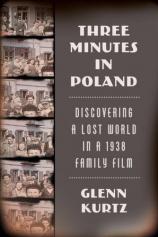Reading Group Guide
Discussion Questions
Three Minutes in Poland: Discovering a Lost World in a 1938 Family Film

1. The archivist Leslie Swift told Glenn Kurtz that his grandfather’s footage is particularly rare because it offers a pre-Holocaust glimpse of Jewish life in a small town, in color; black-and-white Nazi propaganda films and home movies of city life are more common. How did this rare glimpse change your perception of history? What do the lost families of Nasielsk teach us about the past, and the present?
2. The Kurtz film can be retrieved from several online sources, including the author’s website. Your reading group may want to watch the film together. If you have already seen it, which visual details were you drawn to? How were you affected by watching a moving picture, compared to looking at the photographs in the book? What details stood out for you? How would you go about trying to discover the identities of these people?
3. What spurred Glenn’s intensive research on the Nasielsk footage? Why didn’t his father and grandfather take pains to preserve it, as Glenn did? What is different about the way the third generation --- the grandchildren --- can perceive the Shoah?
4. Although David Kurtz referred to life in Nasielsk as “primitive,” what cultural riches did the village experience? Would you have been happy living in a community like theirs, without modern conveniences? What motivated the immigrant David Szmerlak to leave America after 25 years, returning to his homeland to build a yeshiva?
5. We read that Glenn’s grandmother, Liza, felt a special connection to the people of Berezne when she returned to her hometown. What portrait of her emerged as you learned about her life? For Liza and David, what did it mean to be an American? How do you think Glenn’s perception of his grandparents changed over the course of the book?
6. Glenn’s interviews reveal the many social divisions within Nasielsk’s Jewish quarter during the 1930s, based on wealth, education level, religious orthodoxy and line of work. Where would you have ranked in this society? What united the town despite its divisions?
7. As you read Morry Chandler’s harrowing stories of life on the run, in hiding or in disguise, what did you discover about the tactics used to obliterate Jewish communities in Europe --- and the tactics used to try to undermine those efforts?
8. In Glenn’s interviews with the other survivors (Susan Weiss, Leslie Glodek, Mikhail Koprak, Andrzej Lubieniecki, Faiga Tick and Grace Pahl), what common threads emerged? What unique aspects of their lives were especially compelling to you? Do you recognize aspects of your own childhood? How much would you recall if you were asked today to describe your childhood household, school or friends?
9. Discuss the timing of the Kurtz family trip. In what ways is it evidence that the public couldn’t predict or believe the immense scale of Hitler’s plan? When does “history” become “historical” --- different from what we experience every day? Discuss what events in today’s news you think will be significant 25 years from now.
10. When Glenn traveled to Nasielsk (a journey described in Chapter 10), he had to reconcile the images of the past with the 21st-century realities of the town, including the demolition of the synagogue and the inhabitants’ fears that “the Jews” would return to reclaim their stolen property. Beyond factual information, what did Glenn gain by retracing his grandfather’s steps?
11. THREE MINUTES IN POLANDis filled with images of childhood and youth, reminders of the last generation that was born into Nasielsk’s Jewish community. For the survivors who saw David’s film, what did it mean to look at that period of their lives again?
12. Glenn asks in the first chapter, “What moments are worth recording?” What does his grandfather’s home movie tell us about the beauty and significance of ordinary moments? Why is a record of ordinary moments and ordinary people --- not just of the Holocaust period, but for every past epoch --- important to historians?
13. Has the pervasiveness of modern video, from camera phones to YouTube, changed the way we see the world? What are the most meaningful photographs, home movies and other visual artifacts in your family? Which lost chapters do they bring to life? And what previously hidden aspects of life do they make visible? How long do you think these videos will survive? Will the grandchildren of today’s travelers be able to discover our lost world, as Glenn did for the people of Nasielsk?
Three Minutes in Poland: Discovering a Lost World in a 1938 Family Film
- Publication Date: November 17, 2015
- Genres: History, Jewish Interest, Nonfiction
- Paperback: 432 pages
- Publisher: Farrar, Straus and Giroux
- ISBN-10: 0374535795
- ISBN-13: 9780374535797







